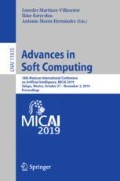Abstract
The correct and continuous use of s3 products at home can be beneficial for the environment and at the same time could generate cost savings on bills. An automated home where the user has no interaction may be the most efficient and eco-friendly option, but it is not always the most comfortable option for the user. On the other hand, if the user interacts with the system as he pleases, the system may be wasting energy, so a middle point must be found. If the system learns about the user’s behavior and tries to shape it in order to make it eco-friendlier with the correct motivation, an engagement to this kind of behavior can be achieve. A first approach of the framework is presented, where a classification of the type of consumer is proposed depending on its personality to find his engagement on ecological behavior (EB). First, an artificial neural network is used to get the personality of the consumer. Then a Mamdani inference system is used with the result of the ANN to get an initial level of ecological behavior engagement.
Access this chapter
Tax calculation will be finalised at checkout
Purchases are for personal use only
References
McCrae, R., Costa, P.: Personality trait structure as a human universal. Am. Psychol. 52, 509–516 (1997)
John, O., Srivastava, S.: The Big Five trait taxonomy: History, measurement, and theoretical perspectives. In: Pervin, L., John, O. (eds.) Handbook of Personality: Theory and Research, pp. 102–138. Guilford Press, New York (1999)
Rothmann, S., Coetzer, E.: The big five personality dimensions and job performance. SA J. Ind. Psychol. 29, 68–74 (2003)
Barrick, M., Mount, M.: The big five personality dimensions and job performance: a meta-analysis. Pers. Psychol. 44, 1–26 (1991)
Judge, T., Higgins, C., Thoresen, C., Barrick, M.: The big five personality traits, general mental ability, and career success across the life span. Pers. Psychol. 52, 621–652 (1999)
Paunonen, S.: Big Five factors of personality and replicated predictions of behavior. J. Pers. Soc. Psychol. 84, 411–422 (2003)
Brick, C., Lewis, G.: Unearthing the “green” personality: core traits predict environmentally friendly behavior. Environ. Behav. 5, 635–658 (2016)
Taciano, L., Chris, G.: The big five personality traits and environmental engagement: associations at the individual and societal level. J. Environ. Psychol. 32, 187–195 (2012)
Jacob, B.: Personality and environmental concern. J. Environ. Psychol. 30, 245–248 (2010)
Boiral, O., Paillé, P.: Organizational citizenship behaviour for the environment: measurement and validation. J. Bus. Ethics 109, 431 (2012)
Lohyd, T., Sowon, K., Sébastien, F.: Who are the good organizational citizens for the environment? An examination of the predictive validity of personality traits. J. Environ. Psychol. 48, 185–190 (2016)
Rammstedt, B., John, O.: Measuring personality in one minute or less: a 10-item short version of the Big Five Inventory in English and German. J. Res. Pers. 41, 203–212 (2007)
Frankel, D., Heck, S., Tai, H.: Using a consumer-segmentation approach to make energy-efficiency gains in the residential market. McKinsey & Company (2013)
N.A.: Open psychology data: Raw data form online personality tests (2019). https://openpsychometrics.org/_rawdata/. Accessed 20 June 2019
Soto, C., John, O.: The next Big Five Inventory (BFI-2): developing and assessing a hierarchical model with 15 facets to enhance bandwidth, fidelity, and predictive power. J. Pers. Soc. Psychol. 113, 117–143 (2017)
Acknowledgement
The authors would like to thank the CITRIS & ITESM funding for the project “A strategy to Increase Energy Savings from Smart Thermostats Based on Gamification and Deep Learning”.
Author information
Authors and Affiliations
Corresponding author
Editor information
Editors and Affiliations
Rights and permissions
Copyright information
© 2019 Springer Nature Switzerland AG
About this paper
Cite this paper
Mata, O., Ponce, P., Méndez, I., Molina, A., Meier, A., Peffer, T. (2019). A Model Using Artificial Neural Networks and Fuzzy Logic for Knowing the Consumer on Smart Thermostats as a S3 Product. In: Martínez-Villaseñor, L., Batyrshin, I., Marín-Hernández, A. (eds) Advances in Soft Computing. MICAI 2019. Lecture Notes in Computer Science(), vol 11835. Springer, Cham. https://doi.org/10.1007/978-3-030-33749-0_34
Download citation
DOI: https://doi.org/10.1007/978-3-030-33749-0_34
Published:
Publisher Name: Springer, Cham
Print ISBN: 978-3-030-33748-3
Online ISBN: 978-3-030-33749-0
eBook Packages: Computer ScienceComputer Science (R0)

